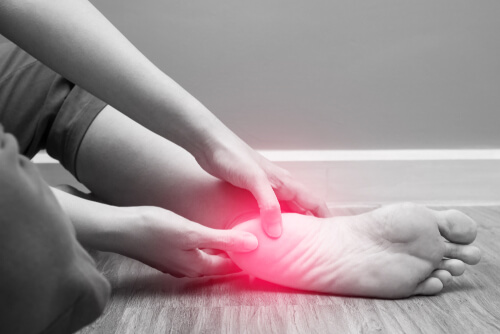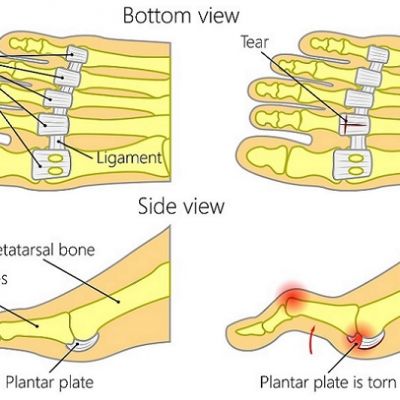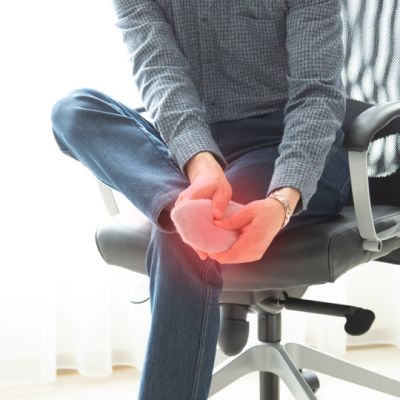Plantar Fasciitis Pain Treatment
Plantar fasciitis pain is the most common complaint that we hear as foot and ankle specialists. This is commonly referred to as heel spur syndrome, but the heel spur is not what causes the pain. It results from inflammation of the plantar fascia, which is the ligament on the bottom of the foot connecting your toes to your heel bone. Symptoms usually occur from overuse of the ligament and/or it being too tight. The symptoms of plantar fasciitis include severe pain in the bottom of the foot or on the heel, which usually gets worse after rest or in the morning. The discomfort from plantar fasciitis can be debilitating for some patients.
Luckily, plantar fasciitis treatment is usually successful without surgery with the use of conservative treatment options such as foot injections, foot orthotics and stretching. However, in about 10% of the population, surgery for plantar fasciitis is necessary. There are several other painful foot problems that mimic plantar fasciitis, and therefore proper diagnosis is important in order to receive the right plantar fasciitis treatment.
Diagnosis of Plantar Fasciitis
The history given by the patient is helpful in the diagnosis and treatment of plantar fasciitis because typically plantar fasciitis pain occurs when one first stands up after rest or in the morning. Other conditions that cause symptoms similar to plantar fasciitis are tarsal tunnel syndrome and a stress fracture of the calcaneus, or heel bone. However, these cause heel or arch pain after prolonged standing or walking. The physical exam by the podiatrist or foot specialist also helps with the diagnosis of plantar fasciitis, as there is typically discomfort when applying pressure to the fascia itself, but not with squeezing of the heel bone or tapping on the tarsal tunnel. Ultrasounds and MRIs are also helpful in the diagnosis of plantar fasciitis so the appropriate treatment plan can be administered.
Conservative Treatment for Plantar Fasciitis
After proper diagnosis is made for plantar fasciitis, the appropriate treatment can be implemented to address your pain and other symptoms of the condition. Plantar fasciitis usually resolves with stretching, arch support and anti-inflammatory medicine. Stretching is easily done by the patient themselves, and can be used in conjunction with night splints and physical therapy to treat your plantar fasciitis.
Anti-inflammatory medicine may be administered by mouth, cream or with foot injections. Arch support may be in the form of a supportive athletic shoe, but is best achieved with a good over the counter rigid foot orthotic, or even custom-made foot orthotics, depending on the patient’s foot type and doctor’s recommendation.

Over the counter foot orthotics from a drug store or shoes store usually do not work fo plantar fasciitis and the associated pain. Quality, effective foot orthotics must be obtained from a podiatrist’s office. While over the counter options are much cheaper, they do not last as long as custom foot orthotics. Fortunately, 90% of patients with plantar fasciitis pain get better with foot orthotics and from doing other conservative treatments alone, but the other minority of patients will require plantar fasciitis surgery to correct the condition.
Foot Injection for Plantar Fasciitis Treatment
The most common injection for Plantar Fasciitis is a cortisone injection. This foot injection reduces inflammation and pain very effectively and can be used safely up to three times per year, as a general rule. More recently, Stem Cells, PRP and Amniotic Fluid foot injections have been used for plantar fasciitis with excellent results. These products are natural, safe and have potent anti-inflammatory properties, while stimulating your body to heal itself in the area of painful plantar fasciitis. Our podiatrists can provide you with more information on the types of foot injections available and which would be the option for your condition.
Plantar Fasciitis Surgery
For the small percentage of people who require plantar fasciitis surgery, a Plantar Fasciotomy is performed. This procedure can be successfully performed by the surgeons at Certified Foot & Ankle Specialist with minimal incisions using a scope, called an Endoscopic Plantar Fasciotomy, or by using an open technique. In either plantar fasciitis surgey, the fascia is released so that it is no longer tight and no longer causes discomfort. Despite common belief, heel spurs typically do not require removal in order to treat plantar fasciitis pain. Plantar fasciitis surgery is extremely successful for most patients and can be performed in an outpatient facility, requiring minimal time off your feet so you can return to work right away.
If you suffer from this condition, you should make an appointment with at Certified Foot & Ankle Specialists to obtain the proper diagnosis and plantar fasciitis treatment plan instead of suffering with pain any longer!
Frequently Asked Questions
The earliest and most characteristic sign of plantar fasciitis is severe pain in the bottom of the foot or heel that occurs when you first stand up after rest, particularly in the morning when getting out of bed. This pain typically subsides after a few steps as the ligament stretches out, but returns after periods of sitting or lying down. The discomfort may start as mild stiffness but can progress to debilitating pain if left untreated.
Diagnosis begins with a detailed patient history, as the timing of pain (worse after rest or in the morning) is a key indicator. During a physical exam, a podiatrist will apply pressure to the plantar fascia to identify areas of tenderness, while ruling out other conditions like tarsal tunnel syndrome or heel bone stress fractures. Ultrasounds and MRIs may be used to confirm the diagnosis and visualize the inflammation, ensuring you receive the appropriate treatment plan.
While plantar fasciitis may improve slightly with rest, it rarely resolves completely without proper treatment. The condition typically requires active intervention including stretching, proper arch support, and anti-inflammatory measures. Without treatment, symptoms often worsen and can become debilitating. However, with appropriate conservative treatment, approximately 90% of patients experience significant improvement without needing surgery.
Stretching is one of the most effective treatments for plantar fasciitis and can be easily performed by patients at home. Specific plantar fascia and calf stretches help lengthen the tight ligament that’s causing pain. These stretches work best when combined with night splints that keep the foot in a stretched position while sleeping, and may be supplemented with professional physical therapy for optimal results.
While over-the-counter orthotics from drug stores typically don’t provide adequate support for plantar fasciitis, quality foot orthotics are essential for treatment success. Professional-grade orthotics must be obtained from a podiatrist’s office for effectiveness. Whether you need custom-made orthotics depends on your specific foot type and your doctor’s recommendation – some patients may benefit from high-quality over-the-counter rigid orthotics, while others require custom fabrication for optimal support and pain relief.
While the content doesn’t specifically address prevention, plantar fasciitis often results from overuse of the plantar fascia ligament and/or excessive tightness. This suggests that maintaining proper foot flexibility through regular stretching, wearing supportive footwear, avoiding overuse activities, and addressing biomechanical issues early may help reduce your risk. If you have risk factors or early symptoms, consulting with a podiatrist can help prevent the condition from progressing to a more painful stage.





